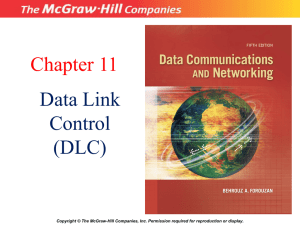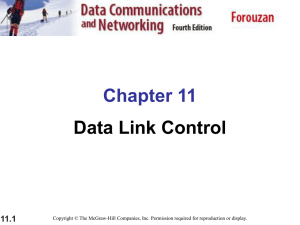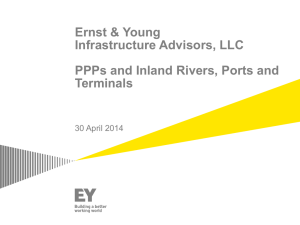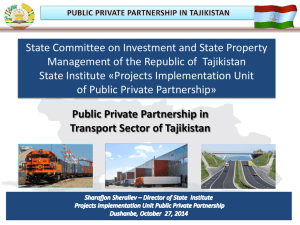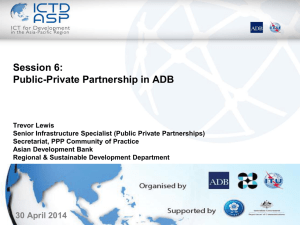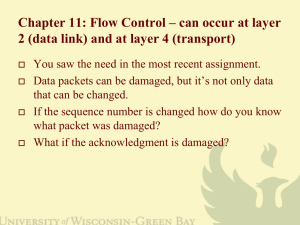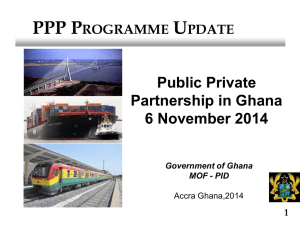Chapter 11 Data Link Control (DLC)
advertisement
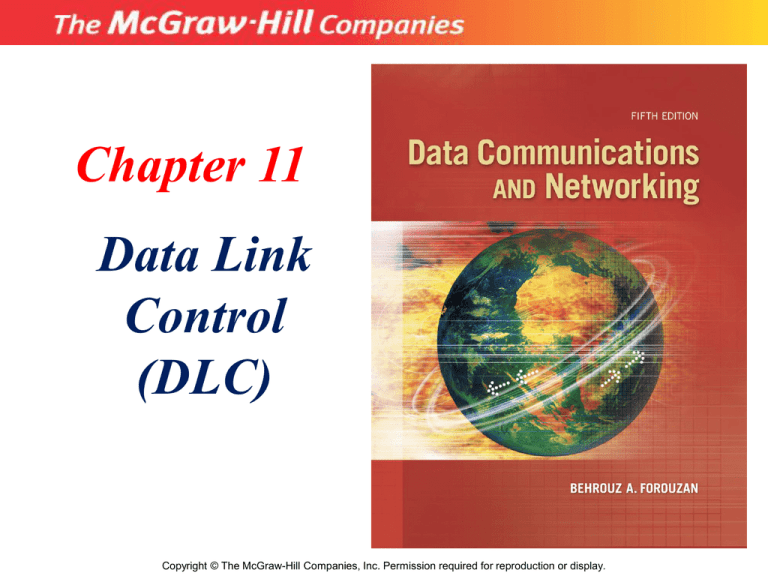
Chapter 11 Data Link Control (DLC) Copyright © The McGraw-Hill Companies, Inc. Permission required for reproduction or display. Chapter 11: Outline 111.1 DLC SERVICES 111.2 DATA-LINK LAYER PROTOCOLS 111.3 HDLC 111.4 PPP Chapter 11: Objective The first section discusses the general services provided by the DLC sublayer. It first describes framing and two types of frames used in this sublayer. The section then discusses flow and error control. Finally, the section explains that a DLC protocol can be either connectionless or connection-oriented.. The second section discusses some simple and common data-link protocols that are implemented at the DLC sublayer. The section first describes the Simple Protocol. It then explains the Stopand-Wait Protocol. Chapter 11: Objective (continued) The third section introduces HDLC, a protocol that is the basis of all common data-link protocols in use today such as PPP and Ethernet. The section first talks about configurations and transfer modes. It then describes framing and three different frame formats used in this protocol. The fourth section discusses PPP, a very common protocol for point-to-point access. It first introduces the services provided by the protocol. The section also describes the format of the frame in this protocol. It then describes the transition mode in the protocol using an FSM. The section finally explains multiplexing in PPP. 11-1 DLC SERVICES The data link control (DLC) deals with procedures for communication between two adjacent nodes no matter whether the link is dedicated or broadcast. Data link control functions include framing and flow and error control. In this section, we first discuss framing, or how to organize the bits that are carried by the physical layer. We then discuss flow and error control. 11.5 111.11.1 Framing The data-link layer needs to pack bits into frames, so that each frame is distinguishable from another. Our postal system practices a type of framing. The simple act of inserting a letter into an envelope separates one piece of information from another; the envelope serves as the delimiter. Framing in the data-link layer separates a message from one source to a destination by adding a sender address and a destination address. The destination address defines where the packet is to go; the sender address helps the recipient acknowledge the receipt. 11.6 Figure 111.1: A frame in a character-oriented protocol 11.7 Figure 111.2: Byte stuffing and unstuffing 11.8 Figure 111.3: A frame in a bit-oriented protocol 11.9 Figure 111.4: Bit stuffing and unstuffing 11.10 111.11.2 Flow and Error Control We briefly defined flow and error control in Chapter 9; we elaborate on these two issues here. One of the responsibilities of the data-link control sublayer is flow and error control at the data-link layer. 11.11 Figure 111.5: Flow control at the data link layer 11.12 Example 111.1 The above discussion requires that the consumers communicate with the producers on two occasions: when the buffer is full and when there are vacancies. If the two parties use a buffer with only one slot, the communication can be easier. Assume that each data-link layer uses one single memory slot to hold a frame. When this single slot in the receiving data-link layer is empty, it sends a note to the network layer to send the next frame. 11.13 111.11.3 Connection A DLC protocol can be either connectionless or connection-oriented. We will discuss this issue very briefly here, but we return to this topic in the network and transport layer. 11.14 11-2 DATA-LINK LAYER PROTOCOLS Traditionally four protocols have been defined for the data-link layer to deal with flow and error control: Simple, Stop-andWait, Go-Back-N, and Selective-Repeat. Although the first two protocols still are used at the data-link layer, the last two have disappeared. We therefore briefly discuss the first two protocols in this chapter. 11.15 Figure 111.6: FSMs 11.16 111.2.1 Simple Protocol Our first protocol is a simple protocol with neither flow nor error control. We assume that the receiver can immediately handle any frame it receives. In other words, the receiver can never be overwhelmed with incoming frames. Figure 111.7 shows the layout for this protocol. 11.17 Figure 111.7: Simple protocol 11.18 Figure 111.8: FSM for the simple protocol 11.19 Example 111.2 Figure 111.9 shows an example of communication using this protocol. It is very simple. The sender sends frames one after another without even thinking about the receiver. 11.20 Figure 111.9: Flow diagram for Example 111.2 11.21 111.2.2 Stop-and-Wait Protocol Our second protocol is called the Stop-and-Wait protocol, which uses both flow and error control. We show a primitive version of this protocol here, but we discuss the more sophisticated version in Chapter 23 when we have learned about sliding windows. In this protocol, the sender sends one frame at a time and waits for an acknowledgment before sending the next one. To detect corrupted frames, we need to add a CRC (see Chapter 10) to each data frame. 11.22 Figure 111.10: Stop-and-wait Protocol 11.23 Figure 111.11: FSM for the stop-and-wait protocol 11.24 Example 111.3 Figure 111.12 shows an example. The first frame is sent and acknowledged. The second frame is sent, but lost. After time-out, it is resent. The third frame is sent and acknowledged, but the acknowledgment is lost. The frame is resent. However, there is a problem with this scheme. The network layer at the receiver site receives two copies of the third packet, which is not right. In the next section, we will see how we can correct this problem using sequence numbers and acknowledgment numbers. 11.25 Figure 111.12: Flow diagram for Example 111.3 11.26 Example 111.4 Figure 111.13 shows how adding sequence numbers and acknowledgment numbers can prevent duplicates. The first frame is sent and acknowledged. The second frame is sent, but lost. After time-out, it is resent. The third frame is sent and acknowledged, but the acknowledgment is lost. The frame is resent. 11.27 Figure 111.13: Flow diagram for Example 111.4 11.28 111.2.3 Piggybacking The two protocols we discussed in this section are designed for unidirectional communication, in which data is flowing only in one direction although the acknowledgment may travel in the other direction. Protocols have been designed in the past to allow data to flow in both directions. However, to make the communication more efficient, the data in one direction is piggybacked with the acknowledgment in the other direction. 11.29 11-3 HDLC High-level Data Link Control (HDLC) is a bit oriented protocol for communication over point-to-point and multipoint links. It implements the Stop-and-Wait protocol we discussed earlier. Although this protocol is more a theoretical issue than practical, most of the concept defined in this protocol is the basis for other practical protocols such as PPP, Ethernet, or wireless LANs. 11.30 111.3.1 Transfer Modes HDLC provides two common transfer modes that can be used in different configurations: normal response mode (NRM) and asynchronous balanced mode (ABM). 11.31 Figure 111.14: Normal response mode 11.32 Figure 111.15: Asynchronous balanced mode 11.33 111.3.2 Framing To provide the flexibility necessary to support all the options possible in the modes and configurations just described, HDLC defines three types of frames: information frames (I-frames), supervisory frames (S-frames), and unnumbered frames (U-frames). 11.34 Figure 111.16: HDLC frames 11.35 Figure 111.17: Control field format for the different frame types 11.36 Example 111.5 Figure 111.18 shows how U-frames can be used for connection establishment and connection release. Node A asks for a connection with a set asynchronous balanced mode (SABM) frame; node B gives a positive response with an unnumbered acknowledgment (UA) frame. After these two exchanges, data can be transferred between the two nodes (not shown in the figure). After data transfer, node A sends a DISC (disconnect) frame to release the connection; it is confirmed by node B responding with a UA (unnumbered acknowledgment). 11.37 Figure 111.18: Example of connection and disconnection 11.38 Example 111.6 Figure 111.19 shows two exchanges using piggybacking. The first is the case where no error has occurred; the second is the case where an error has occurred and some frames are discarded. 11.39 Figure 111.19: Example of piggybacking with and without error 11.40 11-4 PPP One of the most common protocols for point-to-point access is the Point-to-Point Protocol (PPP). Today, millions of Internet users who need to connect their home computers to the server of an Internet service provider use PPP. To control and manage the transfer of data, there is a need for a point-to-point protocol at the data-link layer. PPP is by far the most common. 11.41 111.4.1 Services The designers of PPP have included several services to make it suitable for a point-to-point protocol, but have ignored some traditional services to make it simple. 11.42 111.4.2 Framing PPP uses a character-oriented (or byte-oriented) frame. Figure 111.20 shows the format of a PPP frame. 11.43 Figure 111.20: PPP frame format 11.44 111.4.3 Transition Phases A PPP connection goes through phases which can be shown in a transition phase diagram (see Figure 111.21). 11.45 Figure 111.21: Transition phases 11.46 111.4.4 Multiplexing Although PPP is a link-layer protocol, it uses another set of protocols to establish the link, authenticate the parties involved, and carry the network-layer data. Three sets of protocols are defined to make PPP powerful: the Link Control Protocol (LCP), two Authentication Protocols (APs), and several Network Control Protocols (NCPs). 11.47 Figure 111.22: Multiplexing in PPP 11.48 Figure 111.23: LCP packet encapsulated in a frame 11.49 Table 111.1: LCP Packets 11.50 Table 111.2: Common options 11.51 Figure 111.24: PAP packets encapsulated in a PPP frame 11.52 Figure 111.25: CHAP packets encapsulated in a PPP frame 11.53 Figure 111.26: IPCP packet encapsulated in PPP frame 11.54 Table 111.3: Code values for IPCP Packets 11.55 Figure 111.27: IP datagram encapsulated in a PPP frame 11.56 Figure 111.28: Multilink PPP 11.57 Example 111.7 Let us go through the phases followed by a network layer packet as it is transmitted through a PPP connection. Figure 111.29 shows the steps. For simplicity, we assume unidirectional movement of data from the user site to the system site (such as sending an e-mail through an ISP). 11.58 Figure 111.29: An example 11.59
